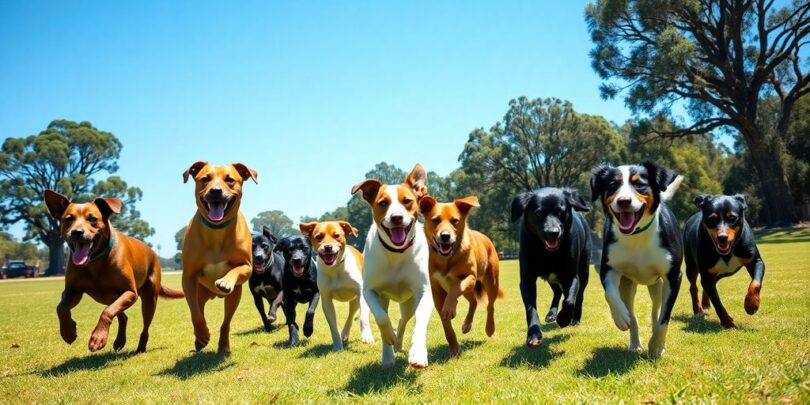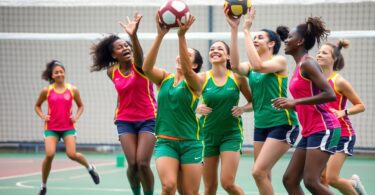Ever wondered why some dog breeds are just everywhere in Australia, while others are a bit harder to spot? It’s not just random luck, mate. There are a bunch of reasons why certain popular dogs in Australia become the talk of the town, from their personalities to how they fit into our lives. Let’s dig into what makes these top blokes so popular down under.
Key Takeaways
- Breeds often become popular because they fit certain lifestyles or trends.
- A dog’s perceived temperament plays a big role in its popularity.
- Some breeds are favoured for specific activities, like working roles or sports.
- Cultural ideas about what makes a ‘good’ dog influence choices.
- The availability of a breed can also affect how many people own them.
1. German Shepherd
Ah, the German Shepherd. A true Aussie icon when it comes to dogs. You see them everywhere, from the park to the beach, and there’s a good reason for that. They’re smart, loyal, and just all-around good blokes. But what makes them so popular here?
First off, their intelligence is off the charts. They learn commands quickly and are always eager to please, which makes training a breeze. This is a big plus for busy Aussies who want a well-behaved dog without spending hours on end in training sessions. They’re also incredibly versatile. Need a family pet? A guard dog? A hiking buddy? The German Shepherd can do it all.
Here’s a few reasons why they’re so popular:
- Loyalty: They stick by your side through thick and thin.
- Trainability: They pick up commands quickly.
- Versatility: They fit into various lifestyles.
I reckon it’s their adaptability that really seals the deal. They can handle the heat, they’re good with kids (when properly socialised, of course), and they’ve got that ‘can-do’ attitude that Aussies admire. Plus, they look pretty darn impressive, don’t they?
But it’s not all sunshine and rainbows. German Shepherds need a job to do. They’re not couch potatoes. If they don’t get enough exercise and mental stimulation, they can become destructive or anxious. So, if you’re thinking about getting one, make sure you’re ready to commit to their needs. It’s also important to find a good breeder. Some German Shepherds can have health problems, like hip dysplasia, so it’s important to do your research and find a breeder who screens their dogs for these issues. Getting your breakfast cereals sorted is easier than finding a good breeder, trust me.
2. Malinois

The Malinois, or Belgian Shepherd Dog, is making waves down under. They’re smart, energetic, and seriously loyal, which makes them great working dogs and companions for active folks. But, like any breed, they’ve got their quirks. You’ll find them working as police dogs, detection dogs, and even competing in agility trials. They’re not just pretty faces; they’re proper athletes.
Their popularity has skyrocketed in recent years, and it’s easy to see why. They’re incredibly versatile and eager to please, but potential owners need to be aware of their specific needs. They aren’t your average couch potato!
Here’s a few things to keep in mind if you’re thinking about getting a Malinois:
- They need heaps of exercise. We’re talking serious runs, not just a quick stroll around the block. Think about dog sports like agility trials or flyball to keep them mentally and physically stimulated.
- Early socialisation is key. Introduce them to different people, dogs, and environments when they’re young to prevent behavioural issues down the track.
- They’re not for first-time dog owners. Malinois need a firm, experienced hand to guide them. They’re too smart to let you get away with anything!
Owning a Malinois is a big commitment. They need a job to do, whether it’s herding sheep or learning new tricks. Without proper stimulation, they can become destructive and anxious. Make sure you’re ready to dedicate the time and energy to meet their needs before bringing one home.
3. Beauceron
Okay, so the Beauceron. These guys are big, bold, and definitely not for the faint of heart. Originally bred as herding dogs in France, they’ve got a serious work ethic and a whole lot of smarts. They’re not as common as some of the other breeds on this list, but they’re definitely making a name for themselves, especially in working roles.
Beaucerons need a job to do, and they need a handler who knows what they’re doing. They’re not the kind of dog you can just leave in the backyard and expect them to be happy. They need consistent training, plenty of exercise, and a strong leader. If you can provide that, you’ll have a loyal and incredibly capable companion.
Think of them as the tradies of the dog world – tough, reliable, and always ready to get the job done. They’re often used in police and military work, excelling in roles that require intelligence, courage, and stamina. They’re also great at dog sports like agility and obedience, where they can really show off their skills.
If you’re considering a Beauceron, do your research. Talk to breeders, meet some dogs, and make sure you’re prepared for the commitment. They’re not a breed for first-time dog owners, but for the right person, they can be an amazing addition to the family. Just remember, they need a job, they need training, and they need a leader. Give them that, and they’ll give you everything they’ve got.
Here’s a quick rundown:
- Energy Level: High. These dogs need a lot of exercise.
- Trainability: Very trainable, but needs a firm, consistent hand.
- Grooming: Minimal. Their short coat is easy to care for.
- Temperament: Loyal, intelligent, and protective. Can be aloof with strangers.
If you’re looking for a dog that’s going to challenge you and keep you on your toes, the Beauceron might just be the breed for you. Just be prepared to put in the work. They thrive as police dogs, so keep that in mind when considering their needs.
4. American Staffordshire
American Staffies, or "Amstaffs" as some call them, have a bit of a reputation, and not always a good one. But honestly, a well-bred and properly trained Amstaff can be an absolute legend. They’re strong, loyal, and can be total goofballs with their families. It’s all about how you raise them, really.
They’re definitely not a dog for first-time owners, though. They need someone who’s firm, consistent, and knows how to handle a powerful dog. Early socialisation is key – get them around other dogs, people, and situations from a young age to avoid any issues down the track.
It’s important to remember that Amstaffs are terriers, and terriers have a strong prey drive. This means they might not be the best choice if you have cats or other small animals. It’s not a guarantee of problems, but it’s something to seriously consider.
They’re also pretty active dogs, so they need plenty of exercise. A good walk or run every day is a must, and they also enjoy things like fetch and agility. Keep them busy, and they’re much less likely to get bored and destructive. If you’re looking for dog training tips, there are plenty of resources available.
Here’s a few things to keep in mind:
- Early Socialisation: Can’t stress this enough. Get them used to everything early.
- Consistent Training: They need a strong leader and clear boundaries.
- Plenty of Exercise: A tired dog is a good dog.
5. Cane Corso

The Cane Corso, also known as the Italian Mastiff, is a seriously impressive dog. They’re big, powerful, and have a history as guardians and hunters. These dogs aren’t for everyone; they need an experienced owner who can provide consistent training and socialisation. If you’re up to the task, you’ll find a loyal and protective companion. But be warned, they can be a handful!
The Cane Corso is known for its confident and assertive nature. They’re not usually the type to back down from a challenge, which is why early and ongoing training is so important. You need to establish yourself as the leader, or they’ll happily take on that role themselves.
They can be wary of strangers, so socialisation from a young age is key to ensuring they’re well-adjusted and don’t become overly protective. It’s not just about meeting people; it’s about positive experiences in different environments. Think puppy classes, walks in the park, and visits to dog-friendly cafes.
Here’s a few things to keep in mind if you’re thinking about getting a Cane Corso:
- They need a job. Whether it’s obedience training, agility, or just being your shadow, they need something to focus their energy on.
- They’re not a ‘set and forget’ breed. Ongoing training and socialisation are essential throughout their lives.
- They can be prone to certain health issues, like hip dysplasia and bloat, so it’s important to get them from a reputable breeder who screens their dogs.
Owning a Cane Corso is a big responsibility. It’s not just about having a cool-looking dog; it’s about providing the right environment, training, and socialisation to ensure they become well-behaved members of society. If you’re not prepared to put in the work, this breed isn’t for you.
One thing that’s interesting about the breed is that they typically lack interest in toys and retrieving, a characteristic well-known within the Cane Corso breed.
6. German Shorthaired Pointer
Okay, so the German Shorthaired Pointer (GSP) – these guys are absolute legends. They’re not just good-looking dogs; they’re proper athletes with brains to match. Originally bred for hunting, they’ve got energy for days and a real zest for life. If you’re after a couch potato, maybe look elsewhere, but if you’re keen on a dog that’ll join you on every adventure, the GSP could be your new best mate.
They’re known for their incredible stamina and trainability, making them fantastic companions for active Aussies.
They’re not just about running around like mad things, though. GSPs are also super affectionate and bond strongly with their families. They can be a bit boisterous, especially when they’re young, so early training and socialisation are key. But with the right guidance, they’ll turn into well-behaved members of the family.
GSPs need a job to do, whether it’s fetching a ball, going for a run, or even just learning new tricks. If they get bored, they can become destructive, so make sure you can commit to giving them plenty of mental and physical stimulation. A bored GSP is not a happy GSP, and a not happy GSP can mean your favourite pair of shoes ends up in pieces.
Here’s a quick rundown of what you need to think about:
- Exercise: These dogs need heaps of it. Think long walks, runs, swims – the works.
- Training: They’re smart cookies, so training is a must. Positive reinforcement works wonders.
- Socialisation: Get them used to different people, places, and other dogs early on to avoid any issues down the track.
They’re also pretty healthy dogs overall, but like all breeds, they can be prone to certain conditions. Hip dysplasia and bloat are a couple to keep an eye on. Regular vet check-ups are always a good idea to keep them in tip-top shape. If you’re looking for dog breeds that are active, this is a great choice.
7. Breton Spaniel
Breton Spaniels are becoming increasingly popular here in Australia, and it’s not hard to see why. They’re energetic, smart, and make fantastic family dogs, especially if you’re an active bunch. They’re originally from France, where they’re known as Epagneul Breton, and they’re renowned for their hunting abilities. But don’t let that fool you; they’re just as happy chilling on the couch after a good run.
One of the things that makes them stand out is their size. They’re not too big, not too small – just right for fitting into most Aussie homes. Plus, they’re relatively easy to train, which is always a bonus. They’re eager to please and love having a job to do, so obedience training is a breeze. Just remember to keep it positive and consistent, and you’ll have a well-behaved mate in no time.
They’re also known for being incredibly affectionate and loyal. They bond strongly with their families and love nothing more than being involved in everything you do. Whether it’s a trip to the beach, a hike in the bush, or just hanging out in the backyard, your Breton will be right there with you. They’re great with kids and other dogs, making them a perfect addition to a busy household.
One thing to keep in mind is that they do need plenty of exercise. They’re a working breed, after all, so they need to burn off that energy. A daily walk or run is a must, and they’ll also appreciate having a backyard to roam around in. If you’re not able to provide them with enough exercise, they can become bored and destructive.
Here’s a quick rundown of what makes them so great:
- Friendly and affectionate nature
- Relatively easy to train
- Good with kids and other dogs
- Adaptable to different living situations (as long as they get enough exercise)
If you’re looking for a dog that’s both a great companion and a capable hunting dog, the Breton Spaniel might just be the perfect fit for you. Just be prepared to give them the love, attention, and exercise they need, and you’ll have a loyal friend for life.
8. Bichon
Okay, so the Bichon Frise. These little fluffballs are surprisingly popular here, and I reckon it’s because they’re basically living teddy bears. They’re small, cute, and don’t shed much, which is a big win for anyone with allergies or who just hates vacuuming every five minutes. Plus, they’re generally pretty happy little dogs, always up for a cuddle or a play.
- Hypoallergenic coat (relatively speaking).
- Adaptable to apartment living.
- Affectionate and playful nature.
They do need regular grooming, though. That white coat doesn’t stay pristine on its own! You’re looking at regular trips to the groomer, or learning to do it yourself, which, let’s be honest, can be a bit of a challenge. But hey, a well-groomed Bichon is a sight to behold.
I reckon a lot of people get Bichons because they want a dog that looks like a puppy forever. And they pretty much get that. They’re not the most robust dogs, so you do need to be a bit careful with them, especially around kids. But if you’re after a small, friendly companion, a Bichon might just be the perfect fit. Just remember to factor in those grooming costs!
Bichons are often chosen for their cheerful disposition and manageable size. They fit well into various lifestyles, from singles in apartments to families in larger homes. However, potential owners should be aware of the commitment required for their coat maintenance. It’s not just about aesthetics; regular grooming is essential for their health and comfort. Neglecting their coat can lead to matting, skin issues, and discomfort for the dog. So, while they might seem like low-maintenance companions, their grooming needs are definitely something to consider before bringing one home. If you’re looking for dog adoption, a Bichon might be a great choice.
9. Jack Russell
Jack Russells! These little dynamos are everywhere in Australia, and for good reason. They’re packed with personality, even if that personality sometimes involves digging up your garden or chasing the postie. They’re not for the faint of heart, but if you’re up for the challenge, they can be amazing companions.
Jack Russells are known for their boundless energy and intelligence. They need plenty of exercise and mental stimulation to keep them happy and out of trouble. A bored Jack Russell is a destructive Jack Russell, trust me on that one.
They’re also incredibly loyal and affectionate with their families. They might be small, but they’ve got a big heart (and a big bark!). Just be prepared for a dog that thinks it’s much bigger than it actually is. They’ll happily take on dogs ten times their size, so early socialisation is key.
Here’s a few things to keep in mind if you’re thinking about getting a Jack Russell:
- They need a firm hand and consistent training. They’re smart, but they’re also stubborn. Effective communication is key.
- They have a high prey drive, so keep them on a lead in areas with wildlife.
- They can be prone to certain health issues, like luxating patellas and lens luxation, so make sure you get them from a reputable breeder.
Owning a Jack Russell is like having a permanent toddler in the house. They’re demanding, energetic, and sometimes a bit of a pain, but they’re also incredibly entertaining and loving. If you can handle the chaos, they’ll bring a lot of joy to your life.
They’re not always the best choice for families with very young children, as they can be a bit nippy if they feel threatened or overwhelmed. But with proper training and socialisation, they can be great family pets. Just remember, they need a job to do, whether it’s chasing a ball, learning new tricks, or just keeping you company on your morning walk.
10. Collie
Collies! Ah, where do I even start? These dogs are just iconic, aren’t they? When you think of a Collie, you probably picture Lassie, the ultimate loyal companion. And that image isn’t too far off the mark. Collies are known for their intelligence, their gentle nature, and their incredible loyalty. They’re fantastic family dogs, especially if you’ve got kids. They’re patient, playful, and always up for a game in the backyard.
One thing to keep in mind is that Collies need a fair bit of exercise. They’re not exactly couch potatoes. They were originally bred as herding dogs, so they’ve got energy to burn. Daily walks, runs, or even a good game of fetch will keep them happy and healthy. Without enough exercise, they can get a bit restless and might start getting into trouble.
Collies are also pretty smart cookies. This means they’re easy to train, but it also means they need mental stimulation. Puzzle toys, training sessions, or even just teaching them new tricks can keep their minds engaged and prevent boredom. A bored Collie is a mischievous Collie, trust me.
Collies do shed, so be prepared for some extra vacuuming. Regular grooming is a must to keep their coats looking their best and to prevent matting. A good brush a few times a week will do the trick, but during shedding season, you might need to up your game.
Collies come in two main coat types: rough and smooth. The rough coat is the classic, long-haired Collie that everyone knows and loves. The smooth coat is shorter and sleeker, but they still have that same Collie charm. Both coat types require regular grooming, but the rough coat obviously needs a bit more attention. If you’re after Australian dog breeds that are both beautiful and intelligent, the Collie is definitely one to consider.
Here’s a quick rundown of what makes Collies so popular:
- Intelligent and easy to train
- Loyal and affectionate
- Good with children
- Need regular exercise and mental stimulation
- Require regular grooming
So, What’s the Go with Our Favourite Pooches?
Alright, so we’ve had a good yarn about why certain dog breeds are just everywhere here in Australia. It’s not always about what makes the most sense, is it? Sometimes it’s just a vibe, or what everyone else is doing. We see how much our own ideas about life, and even ourselves, get mixed up with the kind of dog we bring home. It’s a bit funny, really, how much a dog can say about a person without even trying. And yeah, sometimes those ideas aren’t always fair to the dogs themselves, especially the ones who don’t fit the popular mould. But hey, it’s a good reminder to think a bit more about why we pick the dogs we do, and maybe give a fair go to all the other awesome mutts out there too.
Frequently Asked Questions
Why do people choose particular dog breeds?
Well, it’s a bit of a mix, isn’t it? Sometimes we pick a dog because we just ‘click’ with them. Other times, it might be what we think a certain dog breed says about us. Like, do you want a tough dog or a cute, fluffy one? It often comes down to what we imagine that dog’s life will be like with us, and maybe a bit of what we want others to think of us too.
How do stereotypes affect the dogs we choose and how we see them?
It’s a big deal! What kind of dog you have can tell a story about where you come from, how much money you have, if you’re a bloke or a sheila, and even what you do for fun. Think about it: a tough working dog might suggest a different lifestyle than a tiny lap dog. These ideas, or ‘stereotypes,’ can really stick to dogs and their owners.
Do hobbies and activities influence the type of dog someone gets?
Absolutely! If you’re into dog sports like agility, you’ll often see certain breeds that are super quick and smart, like Border Collies or Jack Russells. And for protection sports, you’ll usually find bigger, stronger dogs like German Shepherds or Rottweilers. People often pick dogs that are good at the activities they enjoy.
Are some dog breeds unfairly judged or stereotyped?
It’s a tricky one. Sadly, some dog breeds, especially the ‘tough’ looking ones like Staffies or Pit Bulls, get a bad rap. People might think they’re dangerous just because of how they look, even if they’re lovely dogs. This means these dogs often have a harder time finding homes and can be misunderstood.
Is choosing a dog breed more about personal preference or social trends?
It’s a bit of both! While some people genuinely love a certain type of dog, others might pick a breed because it’s popular or because they think it makes them look a certain way. It’s like how some people follow fashion trends – dog breeds can have their own trends too!
Have dogs always been symbols of status or identity?
For sure! Dogs have been used throughout history to show off things like power, wealth, or even loyalty. Think of old paintings where important people have specific dogs by their side. Even today, some dogs are seen as a sign of status or a particular lifestyle.








